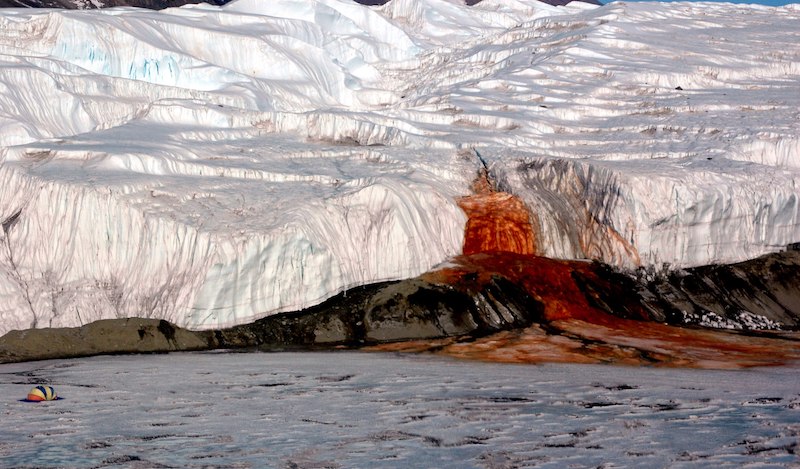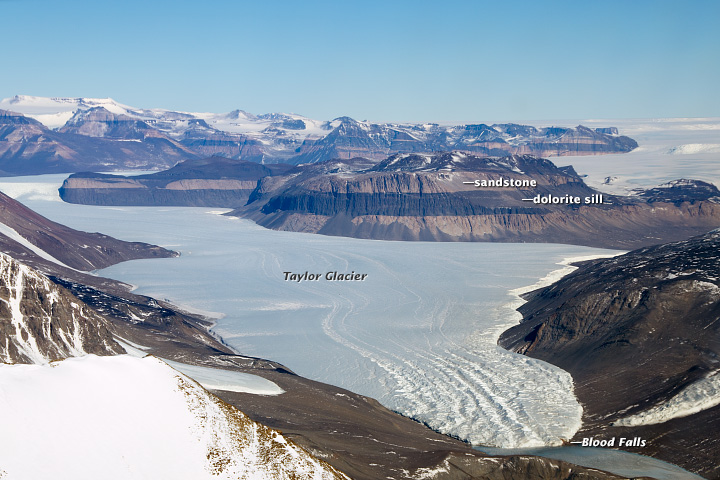
Republished with permission from GlacierHub. This post was written by Arley Titzler. Edits by EarthSky.
Blood Falls stands out among the snow
Amid Antarctica’s vast stretches of glittering white snow and ethereal blue glacier ice is the famous Blood Falls. It’s situated at the terminus of Taylor Glacier in the McMurdo Dry Valleys. Blood Falls is an iron-rich, hypersaline discharge phenomenon. And it spews bold streaks of bright-red brine from within the glacier onto the ice-covered surface of Lake Bonney.
Australian geologist Griffith Taylor was the first explorer to happen upon Blood Falls in 1911. It was during one of the earliest Antarctic expeditions. At the time, Taylor (incorrectly) attributed the color to the presence of red algae. The cause of this color was a mystery for nearly a century. But now we know that the iron-rich liquid turns red when it breaches the surface and oxidizes. In fact, this is the same process that gives iron a reddish hue when it rusts.
A recent study of Blood Falls
The discharge from Blood Falls was the subject of a recent study, published February 2, 2019, in the Journal of Geophysical Research: Biogeosciences. Researchers sought to discern the origin, chemical composition, and life-sustaining capabilities of this subglacial brine. According to lead author W. Berry Lyons of The Ohio State University and his co-researchers:
The brine is of marine origin that has been extensively altered by rock-water interactions.
Researchers used to believe that Taylor Glacier was frozen solid from the surface to its bed. But that changed as measuring techniques have advanced over time. Now scientists have been able to detect huge amounts of hypersaline liquid water at temperatures that are below freezing underneath the glacier. And the large quantities of salt in hypersaline water enable the water to remain in liquid form, even below zero degrees Celsius (32 degrees Fahrenheit).
Researches retrieved direct samples to study
So, seeking to expand on this recent discovery, Lyons and his co-researchers conducted the first direct sampling of brine from Taylor Glacier. They used the IceMole, an autonomous research probe that clears a path by melting the ice that surrounds it. Thus, it collects samples along the way. In this study, the researchers sent the IceMole through 56 feet (17 meters) of ice to reach the brine beneath Taylor Glacier.
Then they analyzed the brine samples to obtain information on its geochemical makeup. Basically, their studies focused on ion concentrations, salinity, and other dissolved solids. So, based on the observed concentrations of dissolved nitrogen, phosphorus, and carbon, the researchers concluded that Taylor Glacier’s subglacial environment has, along with high iron and sulfate concentrations, active microbiological processes. Or in other words, the environment could support life.
Next, to determine the origin and evolution of Taylor Glacier’s subglacial brine, Lyons and his co-researchers pondered other studies’ conclusions in comparison to their results. Finally, they decided the most plausible explanation was that the subglacial brine came from an ancient time when seawater flooded Taylor Valley. However, they did not settle on an exact time estimate.

Its composition doesn’t match seawater
In addition, they found that the brine’s chemical composition was much different than that of modern seawater. So, this suggested that the brine moved through the glacial environment over a long period of time. And, weathering contributed to significant alterations in the chemical composition of the water.
Also, this study provides insights not only for subglacial environments on Earth but potentially for other bodies within our solar system. For example, it’s thought that seven bodies, including Titan and Enceladus (two of Saturn’s moons) and Europa (one of Jupiter’s moons), Pluto and Mars harbor sub-cryospheric oceans.
Lyons and his co-researchers concluded that this subglacial brine environment likely is conducive to life. The ability of sub-cryospheric environments such as this one to support life on Earth hints at an increased possibility of finding life in similar environments elsewhere in our solar system.
Bottom line: A recent study reveals why Antarctica’s Blood Falls is red.











